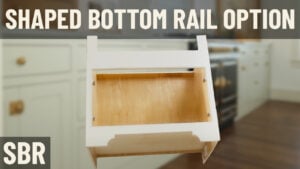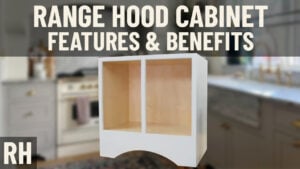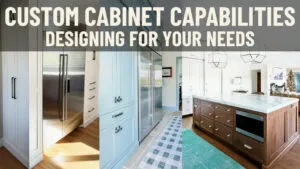Valances are a versatile and creative option in your cabinet design tool kit! They have become increasingly popular as furniture base moldings, in addition to being used as a style elementover a window, range, sink, desk or other area. Valances come in a standard straight version, classic arch, elegant arch, roman arch, or traditional arch. Listen along as Brian guides you through styles, uses, inset vs overlay considerations, pattern sizes, finishes and more. This is a great design option to dress up your kitchen, home office or bathroom. As always, please reach out to your Cabinet Coach with any questions or feedback!
Video Transcript
[Music] Hey everybody, Brian from the cabinet joint. Today's topic is one-piece valances. Hey, Bear, shop dog. Quite popular right now are valances, but not for the things you might think. Valances traditionally are something that goes up high, and these do. This one here is our elegant Arch valance, but what we're talking about is using them as furniture bases as well. So let's start off with what we're offering here. We have five styles ranging from the elegant Arch. This is called a slab valance. It's just a block of wood. And then there are three other pattern valances. So look at the picture shown on the screen there. And there's the traditional Arts, the classic Arts, the Roman Arch. These are all decorative ways to bridge two cabinets up high. Let's say you had a window here and you want to bridge a cabinet and a cabinet. This kind of decorates over the window, maybe over a range, over a sink. Think of places where you want to bridge things. That's the traditional use. Over a desk is another very common area where you have maybe a letter file slot cabinets, and you want to just kind of decorate the area where you're sitting to hide some recess lighting. Very traditional ways to use a one-piece valance.
What we are seeing a lot of these days is people using them as base moldings. So we can do these 4 and 1/2 to 6 inches high. With some special requests, we can actually go a little bit different than that, but the standard is 4 and 1/2 up to six. And what you see is this one's six. So it's not going to really look correct here, but if you had done this 4 and 1/2, this acts as a decorative piece of base molding. We can sell you the pieces to wrap it down the side. You can create some really neat furniture looks with these valances and then put your toe kick 3 inches back. So you know, marbles and things don't roll all the way to the wall, dog hair doesn't go all the way to the wall. 3 inches back, you'd have your normal toe kick. But this gives you a nice furniture style. So bear in mind, you can use these for that. And if you do want to use it as a base molding, any door edge profile, if you go on our website and look at the door edge profile options in the products menu, any of the 22 or 23 edge profiles that you like, we can put on that top edge to kind of dress it up as well as the side pieces. If you want to run a skirt down the side to wrap the cabinet all the way around. So we see people doing this on islands. They'll do the front and back with the valance, the arch valance, and the sides are just capped with a matching base molding with the same top edge. Again, your cabinet coach can really help you with a lot of those decisions, but you can get pretty creative with these.
In the case of inset, because the toe kick is only 4 inches high, you could do a 4 and 1/2 inch valance, and you'd still have wood to nail it to. So you're fine with inset. In the case of overlay, your door hangs all the way to the bottom of that. There's nowhere to tack this piece of molding too. If you were to use it as a base molding, so bear in mind that what I would suggest is you order a little taller and then cut the feet off at the job site, cut the feet off as needed and then mount some blocking on the floor to actually nail it to because you're not going to be able to catch the front of that front frame unless you held your door up a little bit, which you could do and then just catch that edge. So there's some installation things to talk to your cabinet coach about if you're doing full overlay and want to use a valance as a base molding.
Other thing to be aware of is these flats. So these are patterns, and the manufacturer has different pattern widths for various ranges of valances. So let's say from 30 to 36, they use the same pattern width. So what changes on the 30-inch wide valance versus the 36 is this flat area. So you can get some pretty ugly looking flats, some of the places that falls in the range. And this is in our catalog on our website. You can see what the flats will be on a given valance size. You can get a really wide flat, and it looks stupid. We kind of think 3 inches is the right flat amount to get as much pattern as you can get in there, but it looks a little ridiculous to me to have a big giant flat area and a very tiny pattern. So be aware of that, have your cabinet coach guide you, and they can dictate the pattern size they want to get the flat you need. So there are ways we can get around that, but if you just order it standard without being aware of it, you can get some pretty wide flats.
So anyway, that's a good rundown of the valances. Your cabinet coaches can guide you. These are available pretty much in any species, any finish we offer. So you're not limited in any way whatsoever, and they really do a nice job of dressing things up for you. So be sure to add them into your repertoire when you're thinking about your kitchen design. Thanks for watching.




